My previous article for LAAHS concerned Cuba, a subject that became important and interesting to me late in life, after I started traveling to do my research. This one concerns a subject that has been a passion -even an obsession- from the day I first saw an aircraft as a young boy. That aircraft was a North American Harvard, so you can guess where we’re heading.
After more than half a century of studying aircraft and aviation, I think I can say with a certain amount of confidence that no family of aircraft has been more misunderstood, misreported, or generally treated worse by historians than the close to 70 distinct members of the line spawned by North American Aviation’s NA-16. With a little bit of help from my friends and fellow historians, I would like to try to complete and correct the record.
To that end, this article is intended solely as an introduction to a particular group within the confusing world of the NA-16 family -specifically, the “heavyweights” that served in Latin America during the Second World War era.
The drawings you will see are reasonably accurate, but I have not had the time to properly refine them, so please don’t get out your calipers and slide rules! Once again, Chuck Acree has jumped in to produce the color profiles and, in fact, provided the drawing on which his NA-50s profiles are based.
When I can convince myself that I can answer more of my own questions about these aircraft, it is my intention to publish the results of my research in book form. For now, I simply want to share some of the interesting and perhaps ‘myth-shattering’ information I have discovered so far.
Setting the Stage
The company-funded light bomber prototype, the NA-44, was a late ’30s design intended to fill a gap in the inventories of those countries with small budgets. She was no training aircraft -built to accept as many as four fixed .30 caliber machine guns, a flexible gun in the rear cockpit and bomb racks under the center section and outer wings, she was one mean lady!
All of the descendants of the NA-44 were capable of carrying these same armaments -in terms of their internal structure and fittings (although obviously a single seat fighter can not carry a rear flex gun!). It is my opinion that this simple fact has given rise to one of the many misunderstandings I spoke of earlier. There is no question that all of these aircraft were built with the ability to carry the complete array of armaments designed into the NA-44. However, at this point, It is my belief that only the NA-72 actually did so. In spite of documents and previous publications which boldly state that certain aircraft were produced with certain fittings and equipment, I have a tendency to believe a photograph before a document or publication. So, many of my comments and drawings are based on photographs – which, for the most part, at least, don’t lie.
A logical progression of the tube and fabric BT-9/BC-1 line, powered by a Wright R-1820-F52 Cyclone pushing out almost 900 horsepower and armed to the teeth, the NA-44 was the first member of the family to feature the new, all metal, monocoque fuselage construction.
Another innovation came in the form of integral fuel tanks, totaling 170 US gallons. This change produced one of the main points of identification for all of the variants involved -a tear shaped fairing under the center section, which enclosed the sump and fuel selectors. Of note, however, is the curious fact that the fairing on the NA-44 prototype is only about half the size of that fitted to the production aircraft.
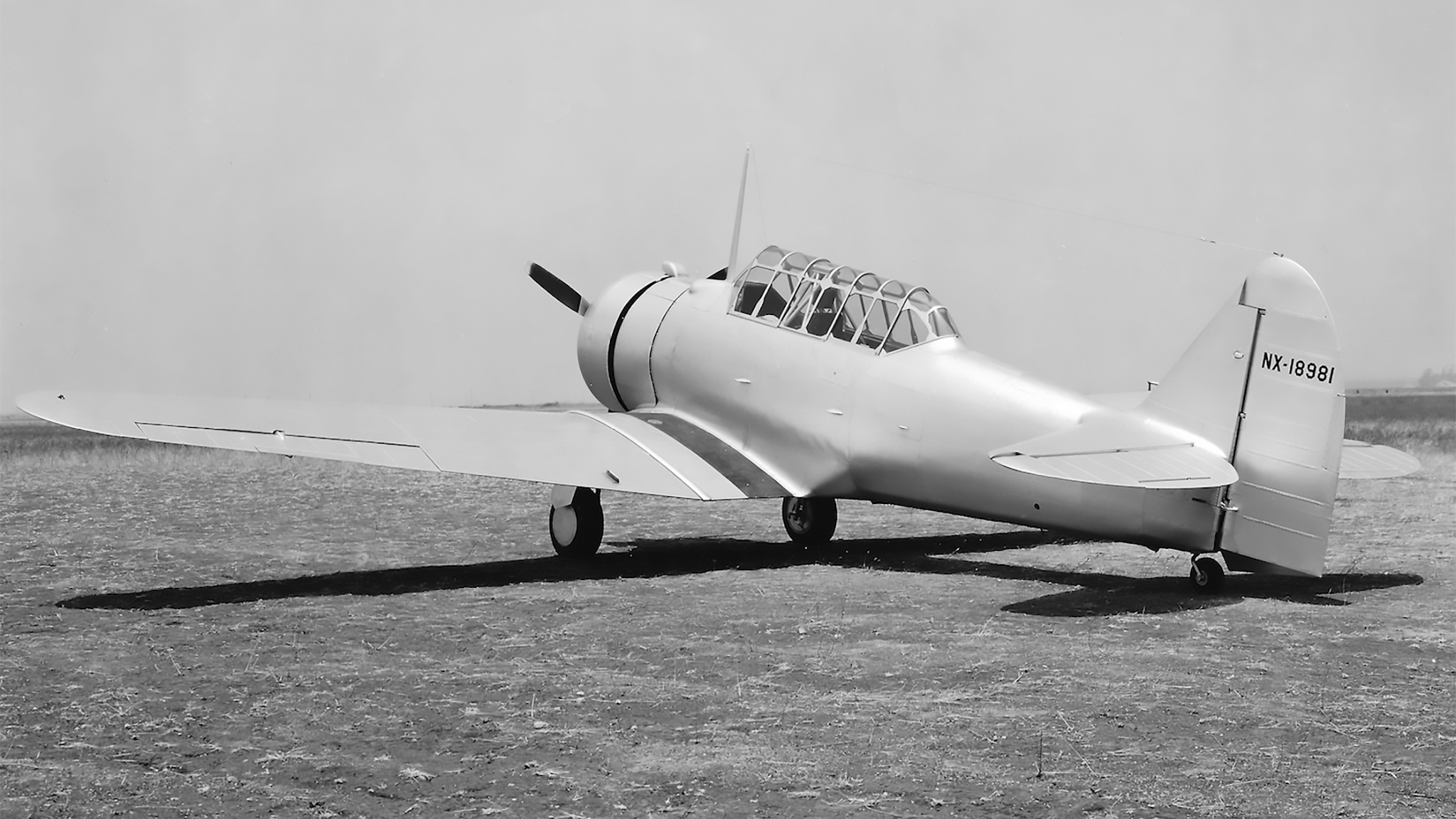
The concept was initiated in September, 1937, and the demonstrator made a relatively successful tour of Latin America the following year, bringing in orders from Perú, Venezuela, Brazil and Chile.
However, even as the tour progressed and orders were coming in, new refinements and developments were taking place in the basic design and only the first order, the 7 single seat fighter variants for Perú, retained the archaic wing form which had survived virtually unchanged from the NA-16 prototype itself!
All of the remaining orders -the two seat variants- received the rudder and wing revisions which had first appeared on the production line on the NA-55, or BC-1A, in mid-1939. The new wing improved the spin/stall characteristics which had haunted all of the NAA trainers up until that point. (With minor modifications, the subsequent order for the BC-1A, charge number NA-59, received the new designation, AT-6, after production began.)
All of the two seater aircraft were related to the NA-44 structurally, but none was related to the NA-44 physically. Powered by Pratt & Whitney R-1340 engines (providing a paltry 550-600 horsepower by comparison), these aircraft all had taller than normal main landing gear, integral fuel tanks, fuel selector fairings, DF footballs suspended below the wing center section and wingspans of 42′ 7″. Length for all models was 29′ 0″.
(In 1940, with the advent of the AT-6A, which had smaller, removable fuel tanks, the fuel selector system was altered, resulting in the removal of the selector teardrop, the narrowing of the center section and the establishment of the more universally recognized span of 42′ 0″.)
Specifications for the NA-44:
Length 27′ 7″
Span 43′ 0″
Ceiling 25,000′
Range 1050 mi
Maximum Speed 250 mph @ 7500′
Cruise 225 mph
Los Toritos
As I mentioned earlier, the NA-50 single seat fighters, ordered for the Cuerpo Aeronáutico del Perú (Peruvian Aeronautical Corps.) in August of 1938, were the only direct descendants of the NA-44. North American promoted the aircraft for their ease of field maintenance, comfortable, spacious cockpit and excellent visibility. In fact, these tough little machines, produced with construction numbers 50-948 to 50-954, must surely have had the best all around visibility of their day, given the fact that their sliding canopies were straight off another NAA product -the O-47 observation plane.
Armament consisted of two .30 cal Colts in the nose decking, with a ring and bead sight, as well as provision for a 400 lb bomb load on NAA flush type racks under the outer wings.
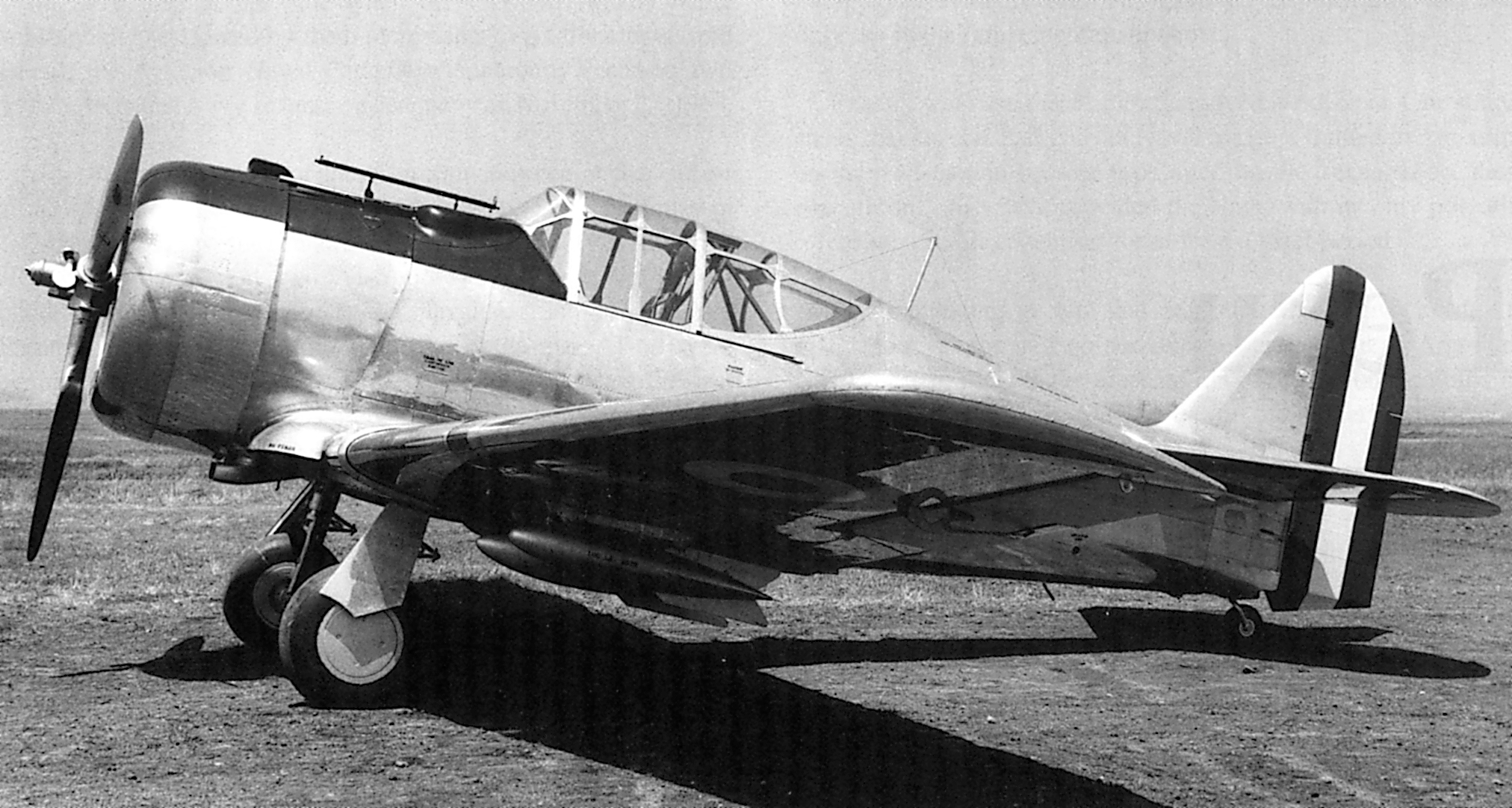
The NA-50’s wing was simply a shortened version of the NA-44 original, with new “flattened” tips replacing the old round ones. A particularly interesting mention in the specifications, reported by Jane’s 1939, is the fact that “wheel type skis may be installed” -a feature certainly not offered on the NA-44! Power came from an 840 hp Wright R-1820-G3 swinging a 3 bladed constant speed prop and the diminutive fighters boasted a climb rate in excess of 3000′ per minute.
Lieutenant Commander Armando Revoredo Iglesias, Captain Jorge Vigil Morey, Sub-Lieutenants Ernesto Gómez Cornejo and Enrique Espinoza Sánchez, and Non-Commissioned Officers Oscar Espejo Castro and Federico Vera Principio made up a special mission that traveled to the United States to inspect and test the various aircraft on order for the CAP. These included Douglas 8A-3Ps and Grumman amphibians, as well as the NA-50s.
When the mission arrived in the United States in September, 1938, The production of the Torito -or little bull, as the Peruvians would call the NA-50– had not even begun, so they were able to follow them every step of the way and make their recommendations and suggestions.
The first aircraft was test flown by NAA test pilot Paul Balfour in February, 1939, and then another NAA pilot, Vance Breese, along with Lieutenants Espinoza and Gómez, flight tested all the remaining machines. A month later, the dismantled airframes were shipped to Callao, Perú on Grace Lines’ “Santa Rosa.”
The NA-50s, Peru’s first aircraft with retractable undercarriages (the 8A-3Ps arrived later), were initially assigned to the 41st Flight of the 21st Fighter Squadron, based at Chiclayo, and serialed XXI-41-1 to XXI-41-7. Barely four months after their arrival, on August 17th, misfortune claimed its first victim, when a Torito flown by Sub Lt. José Sánchez Navarrete crashed at sea during aerobatics.
With the 1941 war between Peru and Ecuador came the NA-50’s “15 minutes of fame.” The most famous of the events in this conflict is, of course, the story of Captain José Abelardo Quiñónes, who deliberately dove his aircraft into an enemy position. A second Torito and pilot were lost when Lt. Renan Elias returned to base with an unexploded bomb hung up on his wing rack. During an attempt to dislodge the bomb before landing, it exploded, with the unfortunate loss of both Elias and his aircraft.
This conflict has been very well documented. For those who would like to learn more, see the Spanish language publication “La Batalla del Lucero“, and the highly recommendable works that the excellent Aero-historian and fellow LAAHSer Amaru Tincopa has published. His books are “Air Wars Between Ecuador and Peru: Volume 1 – The July 1941 War” and “Cuerpo Aeronáutico Del Perú Durante El Conflicto De 1941“, the latter in Spanish.
NA-50 as fighter trainer at the Air Academy in 1947. Four of the Toritos survived the conflict and were transferred to the 21st Squadron, based at Las Palmas, where they served until their place was taken by P-36 Hawks in 1947. Transferred yet again, they became fighter trainers in the 4th Advanced Training Squadron of the 28th Training Squadron at the Air Academy. Wearing serials 28-4-10 to 28-4-13 and a familiar trainer scheme of blue and yellow, they survived in this role until 1950. As is the case with many aging warbirds, they eventually ended up in storage.
A vote of thanks must go to then Colonel Jesús Melgar E. of the Non-commissioned Officers School, who, in 1954, agreed to permit the complete reconstruction of one of the Toritos, number 251 (the aircraft by now had been renumbered 250-253), at the FAP maintenance workshops. After being virtually rebuilt from the ground up, using parts from the other survivors as well as new equipment, the rejuvenated aircraft was test flown over a two day period by Major (now General) César Yepez Zapatero.
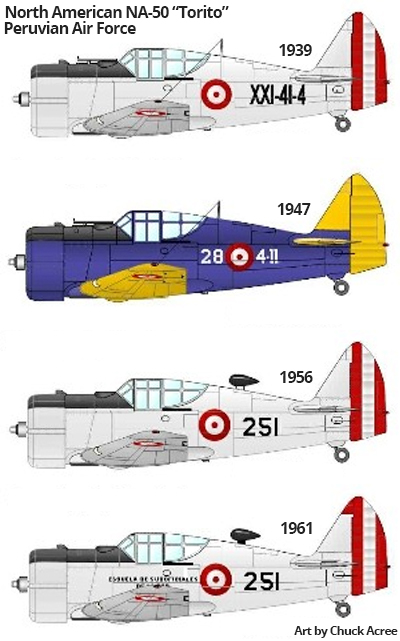
During these flights, the aircraft’s fuselage bore the inscription “Escuela de Suboficiales de la FAP, 1954-1955.” With the completion of these test flights, the aircraft once again returned to the FAP inventory, taking part in air displays until being damaged during a demonstration in 1961.
However, this is still not the end of the story. In 1965, she was once again repaired and placed on a pedestal at Base Aérea Las Palmas, as a tribute to José Abelardo Quiñónes González, whose mausoleum is close by. In fact, in the late 90s, at the insistence of LAAHS member Sergio de la Puente, she received yet another new paint scheme, which more closely approximates that used on Quiñónes’ aircraft, El Pantera.
As is so often the case with long-serving aircraft, there are some minor changes visible, such as the removal of the center frames of the sliding canopy. What is more unusual, though, is the fact that the small number immediately ahead of the horizontal stabilizer is the NAA construction number, 50-951, not the expected air force serial number.
Regardless of minor changes and signs of old age, it is a credit to the Fuerza Aérea del Perú that they have seen fit to preserve this important piece of their history.
Specifications for the NA-50:
Length 27′ 0″ (some sources give 26′ 11″)
Span 37′ 4″ (some sources give 37′ 3″)
Ceiling 32,000′
Range 645 miles
Maximum Speed 295 mph @ 9500′
Cruise 255 mph @ 16,500′
The Mysterious NA-71
Of all the children of the NA-44, the NA-71 was built in the smallest numbers, 3 in fact, and has turned out to be one of the most mysterious. In fact, some may argue that these aircraft do not even belong in this discussion -NAA’s designator for them was NA-16-3, not NA-44. However, in spite of the fact that I have so far not found any real evidence that they were produced with armament, NAA documents describe them as both “General Purpose Combat Aircraft” and “Ground Cooperation Aircraft”, which would suggest that they were intended to be armed. I would be glad to hear from anyone who can shed light on this situation.
Photographs and data are at a premium and the one poor quality, but indisputable photograph I have encountered shows the aircraft unarmed, but definitely exhibiting the abnormally tall landing gear, the center section DF football and the sump fairing. There can be no doubt that the NA-71 belongs in this group. That single photograph also shows an extremely unusual pair of tubular intakes above the exhaust, immediately behind the cowl on the starboard side. These intakes also appear on a number of AT-6s modified by Air France and used as pilot proficiency platforms -25 years later! (Anyone who can clear up the mystery of just what this plumbing was for will receive both my respect and thanks.)
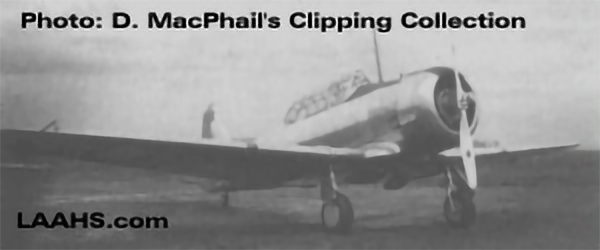
The 3 R-1340-7 powered aircraft, known only by their NAA designation of NA-16-3, were built with construction numbers 71-3074/-3076 and became FAV 1, 2 and 3 in the Fuerza Aérea Venezolana (Venezuelan Air Force.) The final delivery took place in June or July, 1940, and the two survivors were taken out of service in 1943. Last, but not least, judging for the the image included below, there’s no doubt that these airplanes sported an overall dark green scheme at some point in their short careers with the Venezuelan air arm.
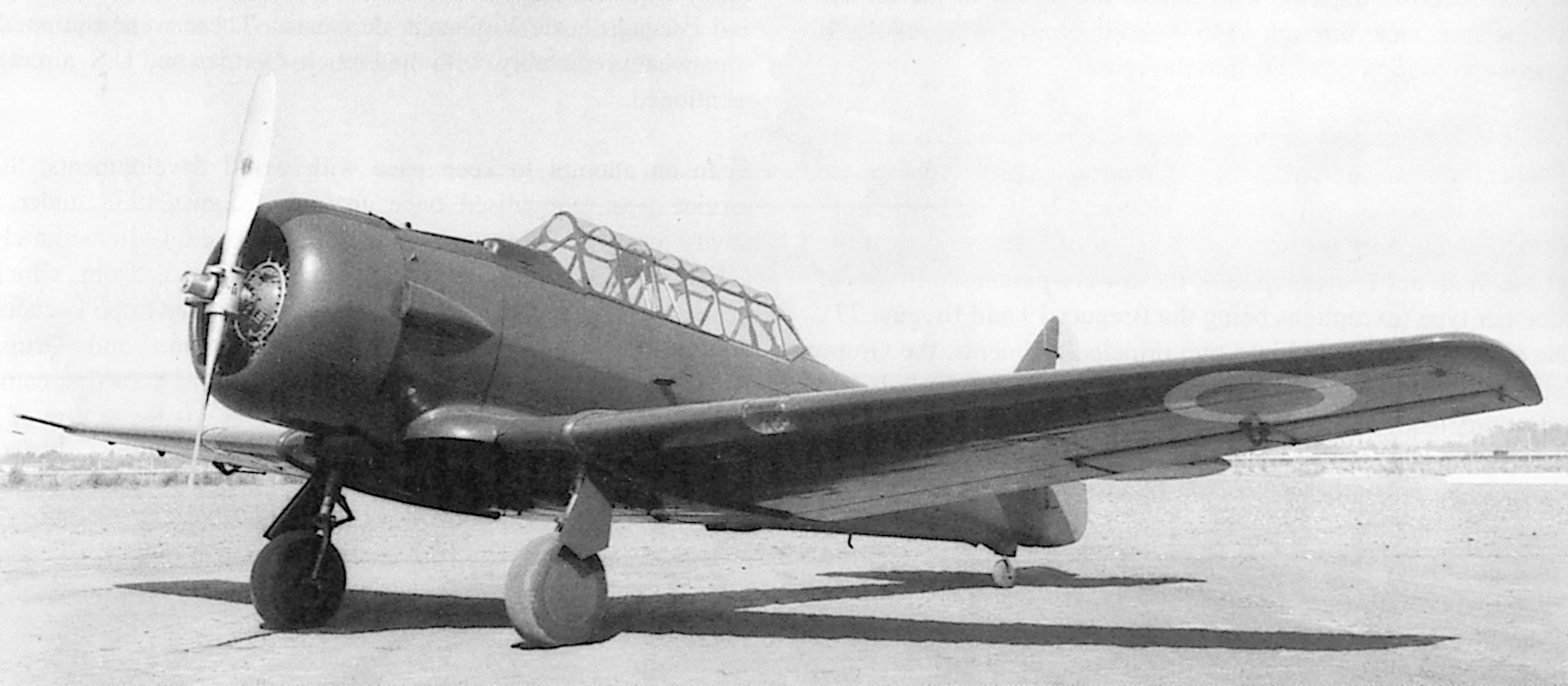
The Brazilian Connection
A contract for 20 examples (72-3077 to 72-3096), valued at US$998,528, (with an option for a further ten machines) was signed on January 12th, 1940 by Gen. Isauro Reguera, Commander of the Diretoria de Aeronáutica do Exército (Directorate of Army Aviation.)
The first flight of the first aircraft took place at Inglewood on July 19th, 1940. Such was the success of this flight that the option for the second group of 10 (72-4757 to 72-4766) was taken up less than a week later. The only difference between the two groups was in terms of the fixed armament fitted. In place of the .30 calibre guns, the second group was to receive 7mm Colts provided by the Diretoria de Aeronáutica do Exército.
Photographs received from the Museu Aeroespacial (Aerospace Museum) show one oddity that apparently did not appear on any of the other “heavyweights” -a pair of venturis located on the forward fuselage- on the port side. These appeared on the starboard side of the NA-44 and NA-50 (just a single unit on the fighter). They also appear on the NA-55 and NA-59 domestic models, but do not appear to have been fitted to either the NA-71 or NA-74 export variants. (I have not yet discovered a photograph of the port side of an NA-71.)
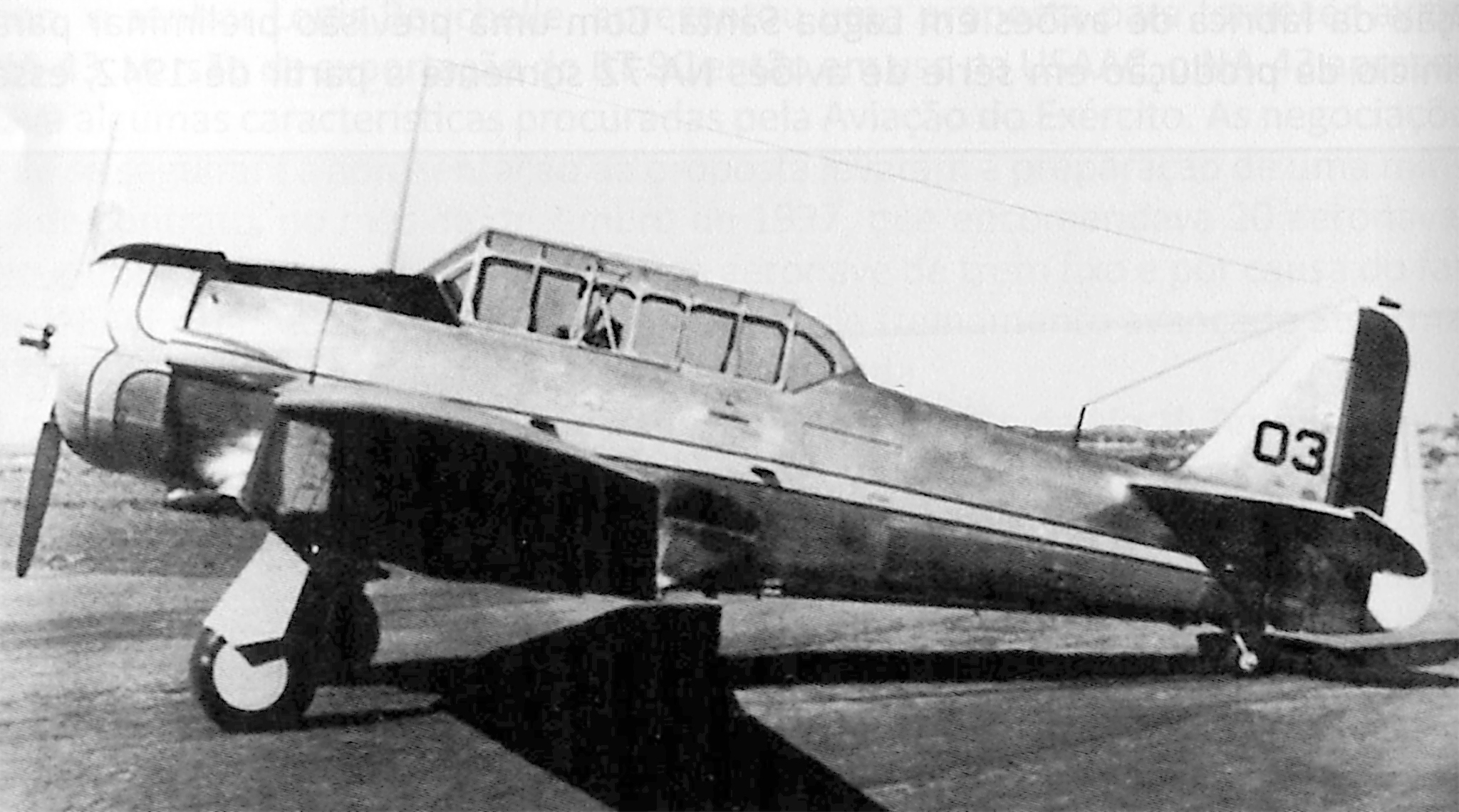
In order to circumvent the inordinate time required for a journey by sea, the NA-72s, serialled simply ’01’ to ’30’, were ferried by Brazilian pilots and mechanics from Inglewood to Campo dos Afonsos air base in five groups, beginning September 11th, 1940. The 15,000 mile journey involved passing through Mexico, Guatemala, Nicaragua, Panama, Colombia, Ecuador, Chile and Argentina.
Initially scheduled for groups of six aircraft, in the event, the flights were made up of 3 groups of 6, with one of 7 and one of 5 machines. The first group arrived at Rio de Janeiro in October, 1940 and the final group reached home 7 months later, on May 20th, 1941. Of the 30 aircraft that began the flight, the only casualty was aircraft number 12 (72-3088), which was written off in an accident at Tuxpan, Mexico, on December 4, 1940.
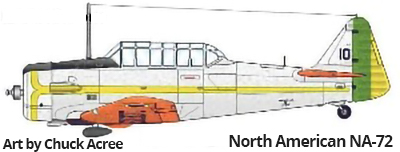
Duties for the NA-72s ranged from third level pilot and gunnery training at the Escola de Aviação Militar (Military Aviation School) at Campo dos Afonsos to coastal patrols, operating from Belém, Fortaleza, Salvador and Recife air bases. Thanks to their range and weapons carrying abilities, they filled this gap admirably until more suitable aircraft could be acquired.
Although there can be little question that it was installed, given the roles played during the wartime period, to date I have not uncovered a single photograph that shows any armament installed in an NA-72 – not during the ferry flights or in service. However, I do have one poor photocopy of a page of color schemes from IPMS Brazil, which clearly shows NA-72 number ’03’, wearing the paint scheme shown in the photo included above, and with guns in the wing and rear cockpit positions. I also have the evidence of a small Brazilian internet site -no longer active unfortunately- which states that the NA-72s were fitted with wing and swivel machine-guns.
At war’s end, the 20 surviving NA-72s were returned to their pilot training duties, but this time at the Escola de Aeronáutica (Aeronautical School), where they lost their somewhat ‘exalted’ position, being redesignated as AT-6s and given serials in the 1000 series, which indicated advanced trainers.
The original contract included a license to build the NA-72 at the Fábrica de Lagoa Santa, but deliveries of 125 AT-6s under Lend-Lease program negated the need for such an endeavor.
The last of the active trainers was struck off charge in 1958, but NA-72 “27” (72-4763), which had been converted to an instructional airframe on April 4th, 1952, remained on the inventory of the Escola de Especialistas da Aeronáutica (Aeronautical Specialists School) until December 20, 1967.
Los Cóndores
In August of 1940, Chile joined the group by ordering 12 examples. Once again, sources seem to be in some conflict as to how these aircraft were armed. One says the fitment was complete, like the NA-44. Another speaks of single nose guns, not two.
At the time of writing, I have been able to uncover 7 photographs and 4 color profiles depicting NA-74 aircraft with both original and late serials. These are, of course, of varying quality, but they do give significant indications as to what equipment was installed. Not one of them shows anything besides the wing guns and outer wing bomb racks. This is not to say that this is how the NA-74 contract negotiations started out, but it is certainly sufficient evidence to state that this is how they were equipped for service.
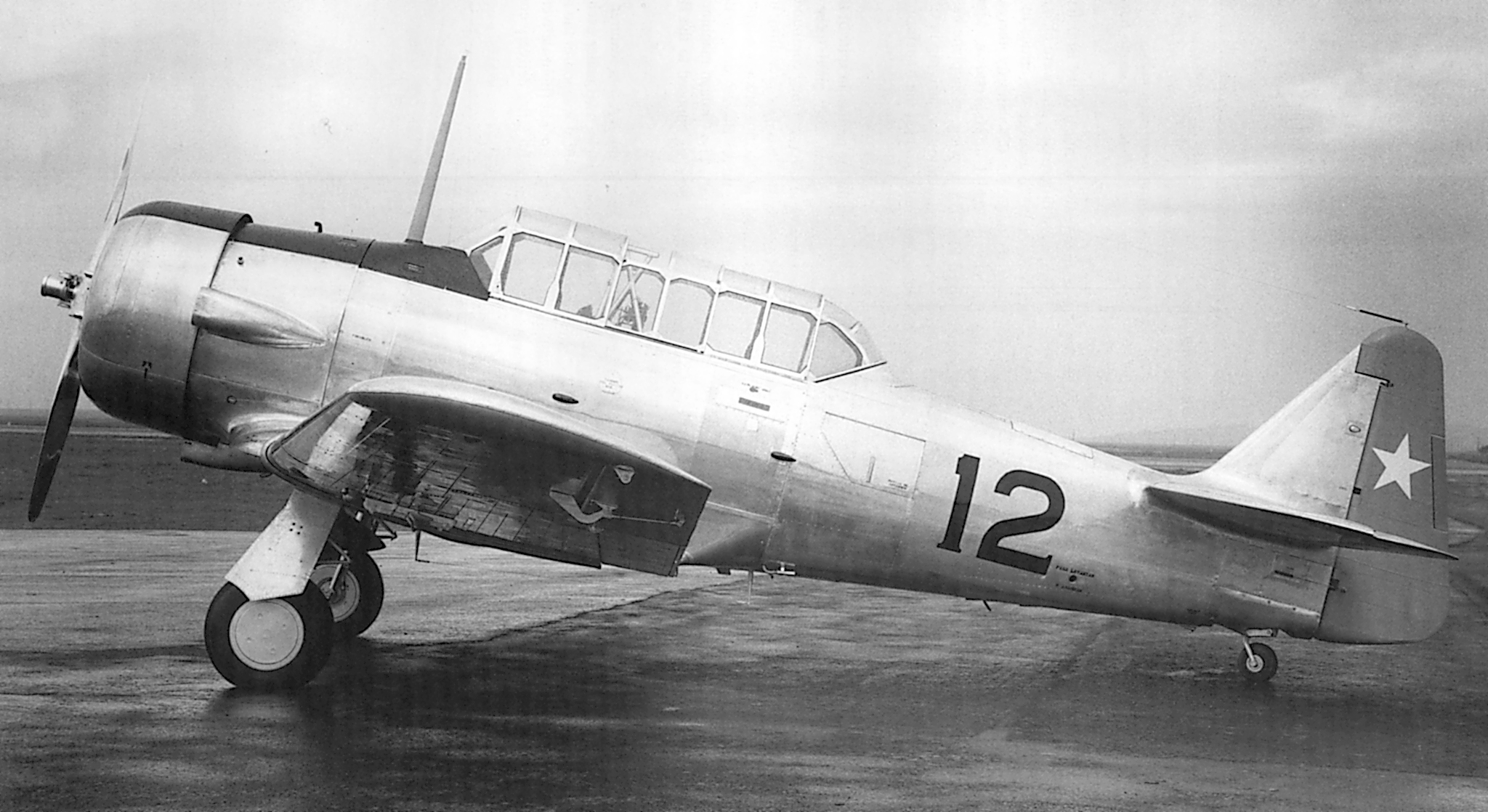
This small collection includes photographs of 7 of the 12 aircraft, in both number sequences, and there are variations in equipment fitted, even on different photographs of the same aircraft. The one article of equipment that is conspicuous by its absence is the nose armament. None of them has it.
I am still investigating the existence of venturis on these aircraft. Thanks to the photographs at hand, I can state with confidence that they were not fitted on the port side, like those on the NA-72s, but so far, I have only a single, very grainy photograph which shows the appropriate position on the starboard side. Oddly enough, there is an indication of what appears to be the attachment point, but no actual venturis are evident.
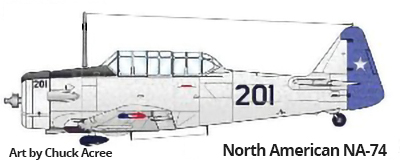
The 12 aircraft, with construction numbers 74-4745 through 74-4756, and serialed simply 1 to 12, were all delivered by February, 1941. In March of the following year, when AT-6 deliveries were in full swing under the Lend-Lease program, the numbering system was altered, and they became 201-212.
Their initial service was split between the Flight School and Air Group No. 4, both based at Santiago. In 1943, aircraft 206, 207 and 208 were transferred to Air Group No. 6, at Punta Arenas.
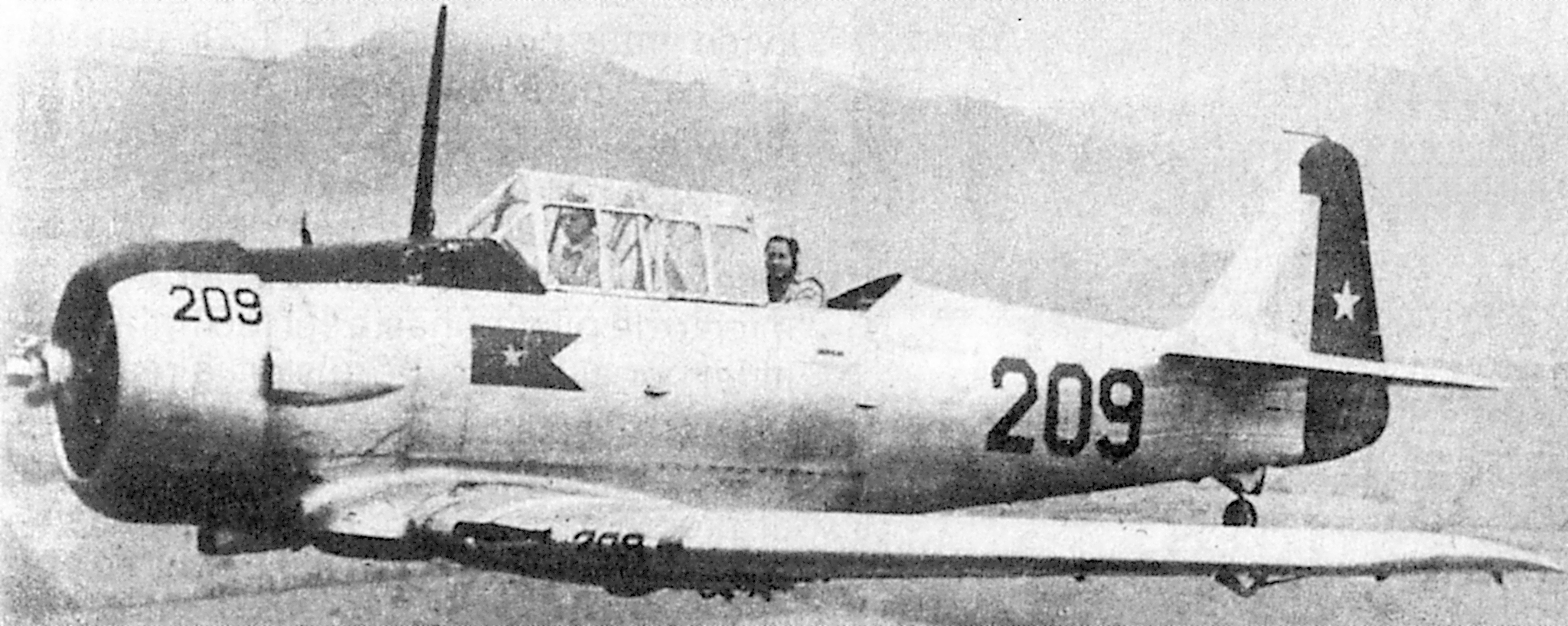
Acknowledgements
The following individuals and groups have enthusiastically and unselfishly provided assistance, in many forms, during my ongoing study of the NA-16 family in Latin America. For this, I am extremely grateful:
Chuck Acree, Fabián Capecchi, Jorge Cobas, Luis Antonio della Rossa, Rudnei Dias da Cunha, General Oscar Gagliardi Kindlimann (FAP), Gary Kuhn, Patrick Lareau, Major JM Monteiro – Museu Aeroespacial, Jorge Núñez Padin, Mario Overall, Dick Phillips, Sergio de la Puente, Santiago Rivas, Tulio Soto, Juan Trevisan.
¡Muchísimas gracias a todos!
This article was originally published on October 2, 2004, in the old LAAHS website. The content of this newer version has been updated by the editorial team.

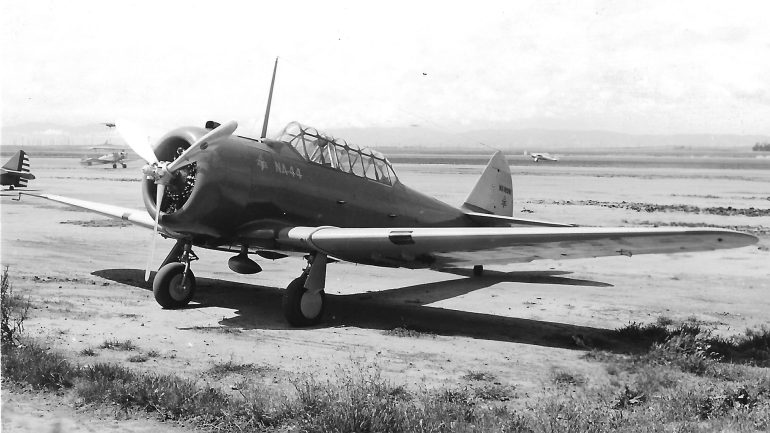
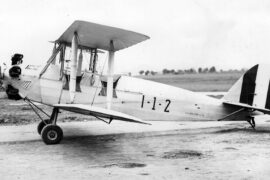
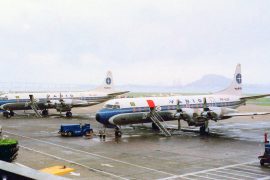
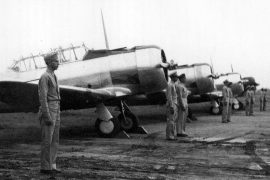
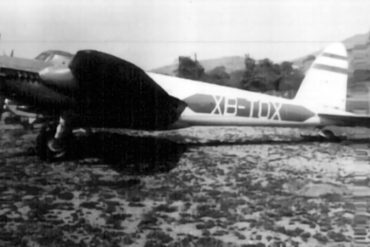
A T-6 Good Morning to Doug and friends! The NA-71’s for Venezuela were, as the second image you used show, armed but did NOT have radios or radio masts as shown on the first (clipping) image in your piece, which is NOT an NA-71. The NA-71s as delivered to Venezuela had more-or-less standard exhausts . According to the NAA descriptive document on the NA-71s held by The Boeing Archives, dated 11 October 1939, they had two 7.7mm fixed guns over the nose and a flexible 7.7mm gun in the rear pit and racks for 10×25 pound or 4×100 pound bombs, identical to the NA-50’s for Peru. The exterior paint was described as “Venezuela green lacquer.”
Hi Mr Hagedorn, I was wondering if there is any further inf of the single BC-1 in Panama, since I would reproduce the model of this aircraft.
Yours sincerely
Thomas Abbondi
Thomas,
Actually, six BC-1’s were assigned to what was then known as the Caribbean Air Force on 29 October 1938, AC38-357 to AC38-362, split evenly (initially) between Albrook and France Field. If you have noticed Volume 1 of “Panama Canal Defenders” from ModelZentrum in Poland, the BC-1’s will be covered in a subsequent volume, as, incredibly, two of the six survived in service with Sixth Air Force until January 1945.